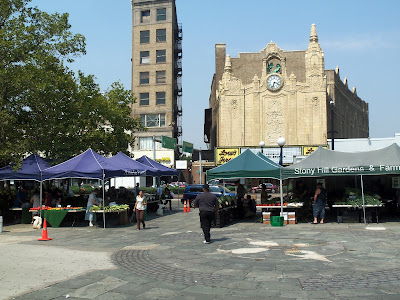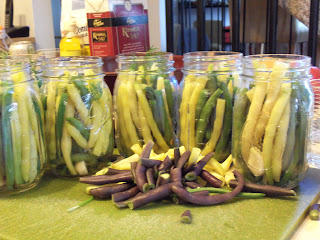
I'm getting a late start in jamming this year, but I've jumped in with both feet into a different method - a copper kettle, less sugar and little or no added pectin, inspired by the recipes from the "Blue Chair Fruit Company" cookbook.
In brief, Rachel uses fresh picked, local fruit; usually mixes it with some sugar and lets it stand overnight; cooks a batch in a copper jam kettle, and concentrates the fruit in a soft thick product.
 |
| Only 8 half-pints from 6 pounds strawberries :-( |
 On June 12, when I was in Pennsylvania visiting my mom, I bought six pounds (four quarts) of locally grown strawberries at Dymond's Farm Market in Dallas PA for $5.25/qt. Though the berries were smaller in size than the supermarket imports from Calif, they were red ripe all the way through and enticingly fragrant with aroma, mmmm.
On June 12, when I was in Pennsylvania visiting my mom, I bought six pounds (four quarts) of locally grown strawberries at Dymond's Farm Market in Dallas PA for $5.25/qt. Though the berries were smaller in size than the supermarket imports from Calif, they were red ripe all the way through and enticingly fragrant with aroma, mmmm.7 cups strawberries
1 cup pineapple,diced
4 cups sugar
3 Tbs lemon juice
If possible, combine the strawberries, pineapple, sugar and lemon juice in a glass or ceramic bowl and let sit overnight in the fridge. Add the mixture to the copper preserving pan and bring to a boil over medium heat, stirring frequently. There will be a lot of bubbles, foam and juice. Start the kitchen timer for 30 minutes. Stirring frequently, adjust the heat a little higher to keep a fast rolling boil. When foam accumulates, lower the heat by half, and skim off the foam. The mixture continues to boil and reduce in volume, after about 15 minutes, the color darkens and the fruit becomes glossy. Start testing for jam consistency by dipping a spoon into the pan and observing the droplets. If it looks thick, and holds it shape, before the timer is up, reduce the heat and skim off any leftover foam. When the timer goes off, turn off the heat and taste it carefully, it's hot.
Take the jars out of the canner and drain them. Fill them up to 1/4 inch from the rim. Wipe the rim clean with a wet paper towel, top with a clean lid and ring. Process in boiling water bath canner for 5 minutes.
 |
| Whole berries, sugar, vanilla bean, lemon juice make preserves |
Strawberry Vanilla Preserves
4 cups smaller whole strawberries, stemmed
2-1/2 cups sugar
1 piece vanilla bean, about 3" long
2 Tablespoons lemon juice
3 Tablespoons dry pectin
 |
| The cutest jar toppers from etsy.com crafter Mud and Twig |
That was all of the strawberries, but I have a few more recipes to try. A new version, recommended by the New York Times, pairs kiwi fruit with strawberries. A trip to the Van Vorst Park ( Jersey City) Farmers' Market, turned up some beautiful stalks of rhubarb, to become a strawberry rhubarb jam. And other explorations....










.JPG)
















